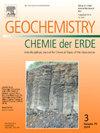Hydrothermal carbonate chimney event from yin’ e basin: Mineralogy, geochemistry, and mode of evolution
IF 2.9
3区 地球科学
Q2 GEOCHEMISTRY & GEOPHYSICS
引用次数: 0
Abstract
Hydrothermal chimney, one of Earth's most mysterious geological events, is crucial for understanding Earth's systems and the history of life. Fine-scale studies of these events help us better understand geological processes, though their transient and complex nature presents significant challenges. Through TIMA, LA-ICP-MS in-situ elemental testing, and Sr and S isotope testing, a relatively complete picture of a carbonate chimney event in the upper section of the Bayingebi Formation in the Yin'e Basin was revealed with high precision. This event was divided into four distinct stages: the prehydrothermal eruption stage, the initial hydrothermal eruption stage, the strong hydrothermal eruption stage and the sustained hydrothermal overflow stage. The pre-hydrothermal eruption stage (Area I) indicates dominant terrigenous sedimentation in a low-energy hydrodynamic environment, with coarse-crystalline calcite enriched in Mn and depleted in K, Na, and Sr and featuring high 87Sr/86Sr values. Subsequently, a transient hydrothermal eruption initiated the deposits in Area II, marked by the appearance of thin-plate calcite and dolomite. During the strong hydrothermal eruption stage (Area III), radial pyrite intersected with calcite, and extensive dolomite precipitation occurred. The 87Sr/86Sr ratio and the δ34SV-CDT value observed may have been a result of the activities of sulfate-reducing bacteria (SRB). In the sustained hydrothermal overflow stage, the eruption intensity decreased, leading to the formation of abundant microcrystalline carbonates in Area IV. Results show regular changes in hydrothermal mineral combinations, eruption modes, material composition, depositional environments, etc., in each stage of the carbonate chimney event, which can provide important information for global lacustrine hydrothermal activity research.
阴鄂盆地碳酸盐热液烟囱事件:矿物学、地球化学及演化模式
热液烟囱是地球上最神秘的地质事件之一,对了解地球的系统和生命的历史至关重要。对这些事件的精细研究有助于我们更好地理解地质过程,尽管它们的短暂性和复杂性带来了重大挑战。通过TIMA、LA-ICP-MS原位元素测试和Sr、S同位素测试,高精度地揭示了阴娥盆地巴音格壁组上段碳酸盐烟囱事件较为完整的图像。该事件可分为热液喷发前阶段、初始热液喷发阶段、强烈热液喷发阶段和持续热液溢出阶段四个阶段。热液喷发前阶段(I区)以陆源沉积为主,为低能水动力环境,粗晶方解石富Mn,贫K、Na、Sr, 87Sr/86Sr值较高。随后,短暂的热液喷发在II区形成了以薄板方解石和白云岩为标志的矿床。在强热液喷发阶段(III区),黄铁矿与方解石呈放射状相交,白云岩大面积沉淀。87Sr/86Sr比值和δ34SV-CDT值可能是硫酸盐还原菌(SRB)活性的结果。在持续的热液溢出阶段,喷发强度减弱,导致IV区形成了丰富的微晶碳酸盐。结果显示,碳酸盐烟囱事件各阶段热液矿物组合、喷发方式、物质组成、沉积环境等均有规律性变化,可为全球湖泊热液活动研究提供重要信息。
本文章由计算机程序翻译,如有差异,请以英文原文为准。
求助全文
约1分钟内获得全文
求助全文
来源期刊

Chemie Der Erde-Geochemistry
地学-地球化学与地球物理
CiteScore
7.10
自引率
0.00%
发文量
40
审稿时长
3.0 months
期刊介绍:
GEOCHEMISTRY was founded as Chemie der Erde 1914 in Jena, and, hence, is one of the oldest journals for geochemistry-related topics.
GEOCHEMISTRY (formerly Chemie der Erde / Geochemistry) publishes original research papers, short communications, reviews of selected topics, and high-class invited review articles addressed at broad geosciences audience. Publications dealing with interdisciplinary questions are particularly welcome. Young scientists are especially encouraged to submit their work. Contributions will be published exclusively in English. The journal, through very personalized consultation and its worldwide distribution, offers entry into the world of international scientific communication, and promotes interdisciplinary discussion on chemical problems in a broad spectrum of geosciences.
The following topics are covered by the expertise of the members of the editorial board (see below):
-cosmochemistry, meteoritics-
igneous, metamorphic, and sedimentary petrology-
volcanology-
low & high temperature geochemistry-
experimental - theoretical - field related studies-
mineralogy - crystallography-
environmental geosciences-
archaeometry
 求助内容:
求助内容: 应助结果提醒方式:
应助结果提醒方式:


